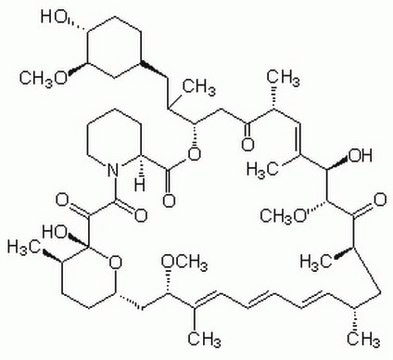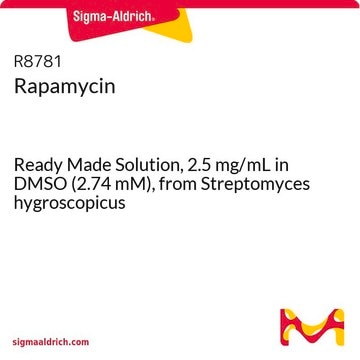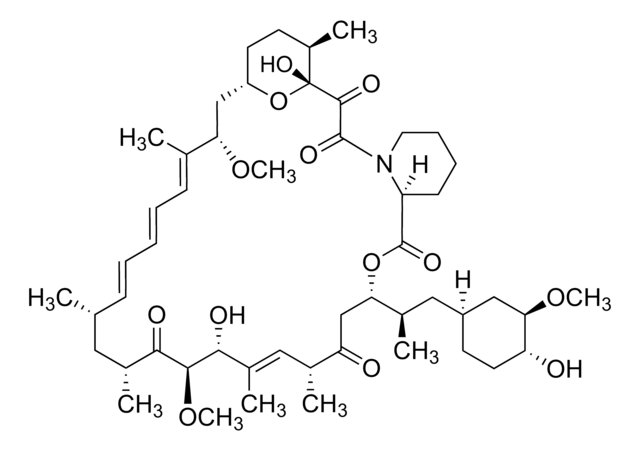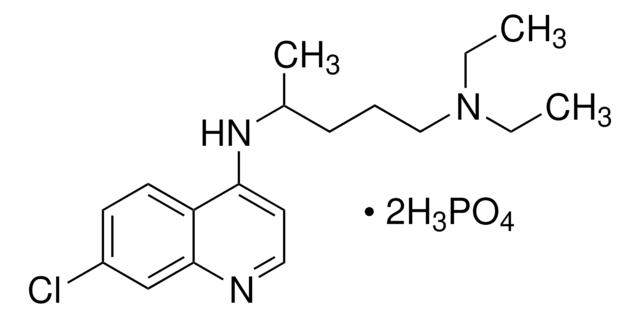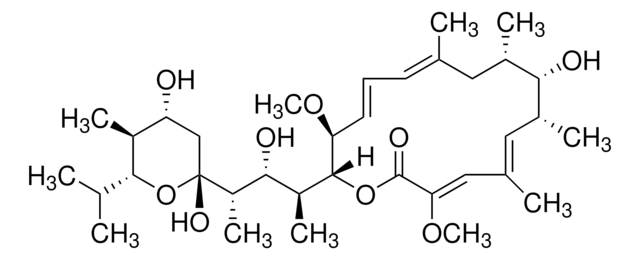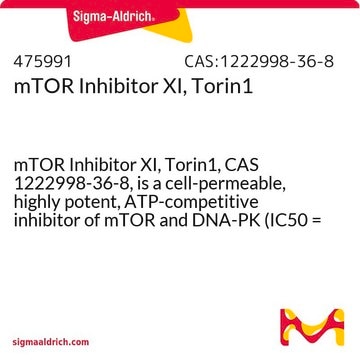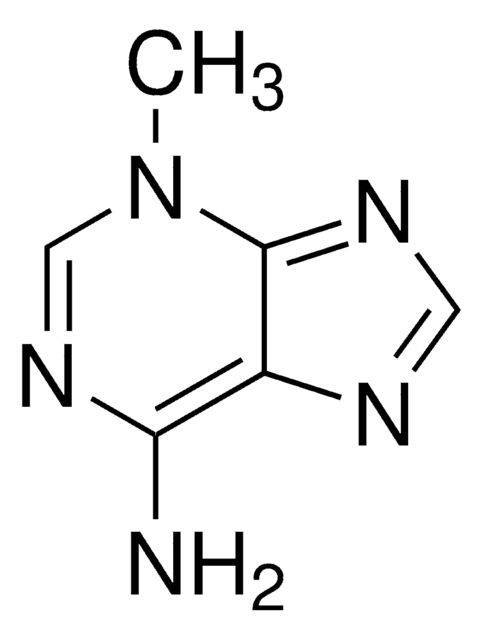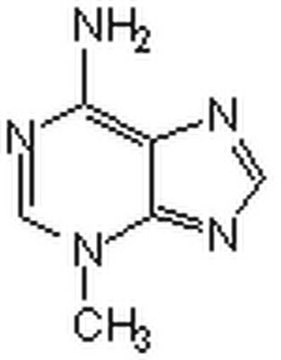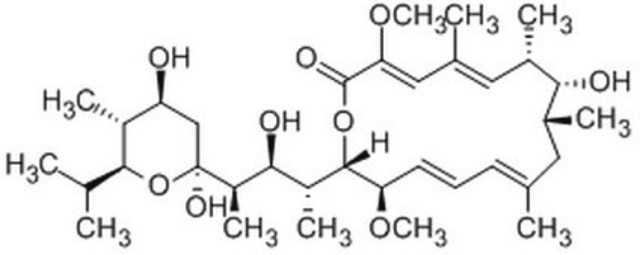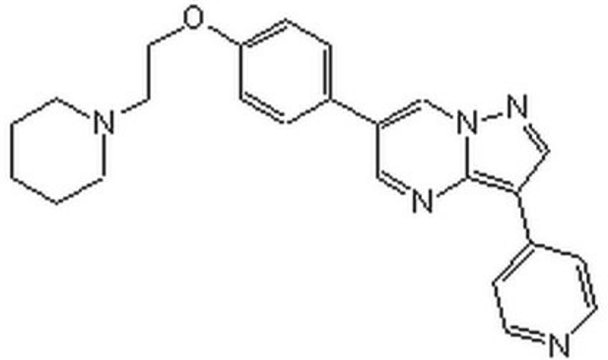553211
Rapamycin
≥95% (HPLC), solution, mTOR inhibitor, Calbiochem
Synonym(s):
InSolution Rapamycin, mTOR Inhibitor I
Sign Into View Organizational & Contract Pricing
All Photos(1)
About This Item
Empirical Formula (Hill Notation):
C51H79NO13
Molecular Weight:
914.17
UNSPSC Code:
12352200
NACRES:
NA.77
Recommended Products
product name
Rapamycin, InSolution, ≥98%, 5 mM, inhibits mTOR and blocks activation of p70 S6 Kinase
Quality Level
assay
≥95% (HPLC)
form
solution
manufacturer/tradename
Calbiochem®
storage condition
desiccated (hygroscopic)
protect from light
shipped in
wet ice
storage temp.
−20°C
General description
Selectively inhibits the phosphorylation and activation of p70 S6 kinase (IC50 = 50 pM). Prevents the translational activation of IGF-II. Also prevents resting T-cells from entering the cell cycle, but does not directly arrest cell cycle progression. Shown to inhibit later signaling events, such as p110Rb phosphorylation, p34cdc2 kinase activation, and cyclin A synthesis. Exhibits strong binding to FK-506 binding proteins. Also reported to induce apoptosis in a murine B-cell line, to inhibit lymphokine-induced cell proliferation at the G1 phase, and to irreversibly arrest Saccharomyces cerevisiae cells in the G1 phase.
Biochem/physiol Actions
Cell permeable: no
Primary Target
Mammalian target of rapamycin (mTOR)
Mammalian target of rapamycin (mTOR)
Product does not compete with ATP.
Reversible: no
Target IC50: 50 pM inhibiting the mammalian target of rapamycin (mTOR) and blocking the subsequent activation of p70 S6 kinase
Packaging
Packaged under inert gas
Warning
Toxicity: Irritant (B)
Physical form
A 5 mM (500 µg/109 µl) solution of Rapamycin (Cat. No. 553210) in DMSO.
Reconstitution
Following initial use, aliquot and freeze (-20°C).
Legal Information
CALBIOCHEM is a registered trademark of Merck KGaA, Darmstadt, Germany
wgk_germany
WGK 1
flash_point_f
188.6 °F
flash_point_c
87 °C
Certificates of Analysis (COA)
Search for Certificates of Analysis (COA) by entering the products Lot/Batch Number. Lot and Batch Numbers can be found on a product’s label following the words ‘Lot’ or ‘Batch’.
Already Own This Product?
Find documentation for the products that you have recently purchased in the Document Library.
Customers Also Viewed
Rachel M Wise et al.
Cells, 9(10) (2020-10-04)
Human adipose-derived stem cells (ASCs) show immense promise for treating inflammatory diseases, attributed primarily to their potent paracrine signaling. Previous investigations demonstrated that short-term Rapamycin preconditioning of bone marrow-derived stem cells (BMSCs) elevated secretion of prostaglandin E2, a pleiotropic molecule
Clarissa Braun et al.
Cell stress, 5(12), 176-182 (2021-12-18)
Programmed cell death protein 4 (PDCD4) exerts critical functions as tumor suppressor and in immune cells to regulate inflammatory processes. The phosphoinositide 3-kinase (PI3K) promotes degradation of PDCD4 via mammalian target of rapamycin complex 1 (mTORC1). However, additional pathways that
Tom Kaufman et al.
Nature communications, 13(1), 2725-2725 (2022-05-19)
While multiplexing samples using DNA barcoding revolutionized the pace of biomedical discovery, multiplexing of live imaging-based applications has been limited by the number of fluorescent proteins that can be deconvoluted using common microscopy equipment. To address this limitation, we develop
Shuhang Dai et al.
Biochimica et biophysica acta. Molecular cell research, 1869(7), 119252-119252 (2022-03-11)
Engagement of epidermal growth factor (EGF) with its receptor (EGFR) produces a broad range of cancer phenotypes. The overriding aim of this study was to understand EGFR signaling and its regulation by the Ca2+/calmodulin (CaM) dependent protein kinase kinase 2
Olivia J James et al.
Nature communications, 12(1), 4290-4290 (2021-07-15)
Intestinal intraepithelial lymphocytes (IEL) are an abundant population of tissue-resident T cells that protect and maintain the intestinal barrier. IEL respond to epithelial cell-derived IL-15, which is complexed to the IL-15 receptor α chain (IL-15/Rα). IL-15 is essential both for
Our team of scientists has experience in all areas of research including Life Science, Material Science, Chemical Synthesis, Chromatography, Analytical and many others.
Contact Technical Service